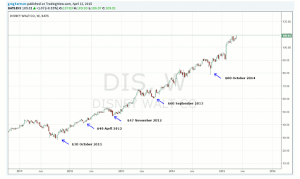Greg Harmon, of Dragonfly Capital, uses the story of guest speaking at his daughter’s school and arguing with her teacher—a former financial advisor—to illustrate that rather than the ingrained ‘buy low sell high’ adage, traders should consider the strategy of ‘buying high and selling higher’ instead.
Despite the markets remaining near all time highs, there are many people that are frightened of putting money to work in the S&P 500. It probably comes from an old investing wives’ tale, or meme, as we call them now. I heard it when I spoke to my daughter’s second grade class on Career Day last week.
The teacher, who had worked for a year as a financial advisor 20 years ago, has been teaching the kids about economics. Well, as much as you can teach 8-year olds. When it came to stocks, the class chose 4 to follow, Walt Disney, Apple, Starbucks, and Nike. After a week, they were experts (sounds like Twitter traders) and ready to express their opinions, including the teacher.
I started my presentation to the children and happened to have a 4-year chart of Walt Disney (DIS), moving strongly from the lower left to the upper right, they could easily identify the trend. Up. That is when it happened. The teacher jumped in to tell the class that this would not be a good stock to buy because you “buy low and sell high.” The kids all chimed in before she could finish. I immediately corrected her. Actually, buying high and selling higher is a great strategy. We then got into a wrestling match and now I am looking for a new school for my daughter.
Seriously though, this adage of buying low and selling high is deeply ingrained. It is a process that needs to be unlearned and fast. First, it does not make any sense. If you followed it, where is high? Above the last high? Above where you bought it? Somewhere in between? None of the above? The same goes for low.
And what if you only waited for a stock to be low to buy? Assuming that the October 2011 low was low enough for Disney, you got a great deal at $30. But if you did not buy it then…was it really wrong to buy it at the April 2012 low at $40, 33% higher? Or the November 2012 low at 47? What about the September 2013 low at 60? Or the October 2014 low at 80? These late buy points were 33%, 56%, 100%, and 165% above the April 2012 low at 30. But they also would have given 170%, 131%, 81%, and 36% returns through last Thursdays’ new all time high close at 109.
The point is…buying high cannot be dismissed. Strong stocks or markets trend and if you only give yourself one chance to participate then you are working with both hands tied behind your back. You never know when the ultimate or intermediate top will happen. Yes it could be the day you buy. But it could be 170% or more higher. Time to rethink your thinking.
By Greg Harmon of Dragonfly Capital






















